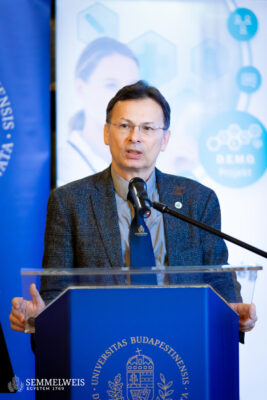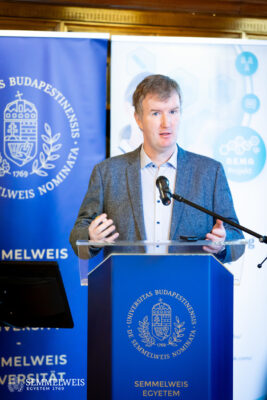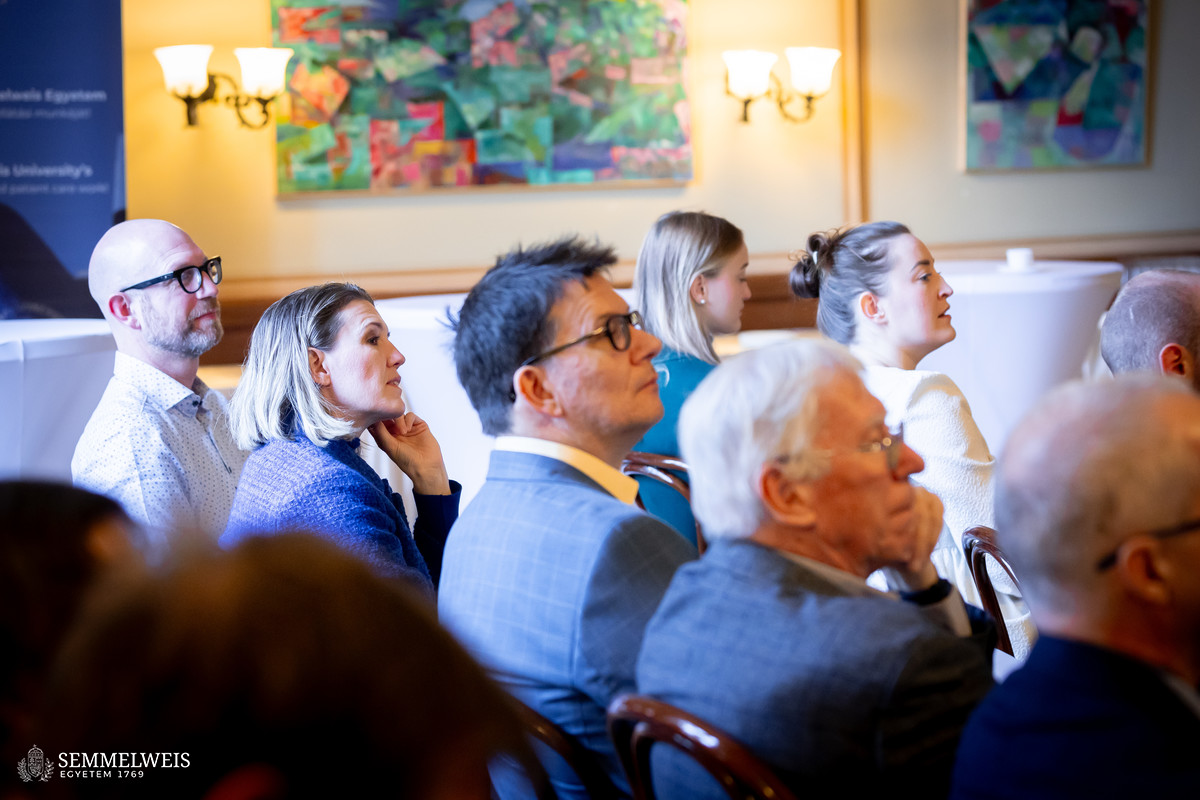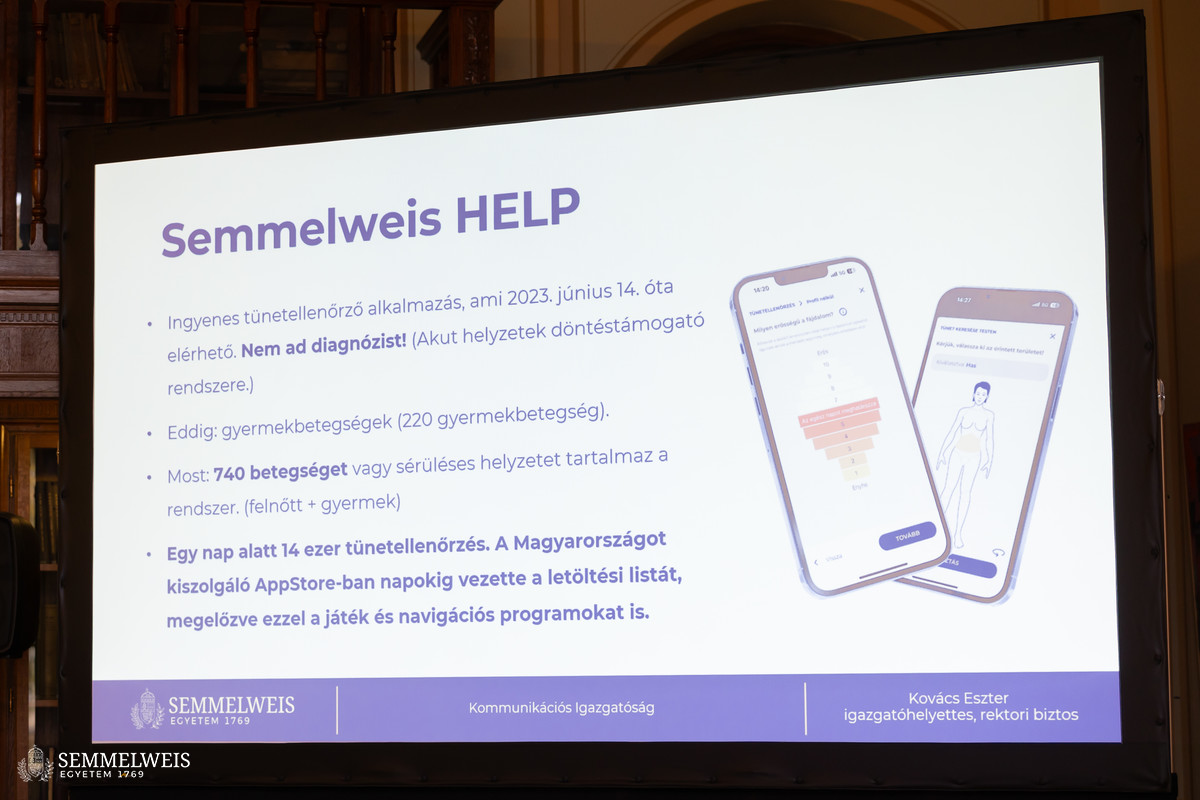 The challenges of the coronavirus pandemic accelerated the adoption and spread of digital health tools. While in 2021, during the pandemic, one third of the population used smart devices and health-related applications, the figure is now 50 percent. Today, digital health solutions are an integral part of care, stressed Dr. Éva Szabó Fekete, Vice-Rector for Strategy and Development at Semmelweis University, in her opening address. As she pointed out, the research results of the university’s Digital Health Research Group showed that society expected doctors to be not only healers but also guides of the digital world.
The challenges of the coronavirus pandemic accelerated the adoption and spread of digital health tools. While in 2021, during the pandemic, one third of the population used smart devices and health-related applications, the figure is now 50 percent. Today, digital health solutions are an integral part of care, stressed Dr. Éva Szabó Fekete, Vice-Rector for Strategy and Development at Semmelweis University, in her opening address. As she pointed out, the research results of the university’s Digital Health Research Group showed that society expected doctors to be not only healers but also guides of the digital world.
Patients are increasingly looking to healthcare professionals for guidance on digital health. These challenges also need to be addressed in medical education. An example of this could be our wide range of optional subjects. – Dr. Éva Szabó Fekete
The research presented here will also contribute to future developments and further progress. She underlined that 34 scientific publications were related to this research project, several of which had been published in D1 journals. She added that this was a very dynamic field in terms of research & development, and that it was a pleasure to see that Semmelweis University, as the leading medical and health sciences knowledge center in the country and the region, was at the forefront of this new strategic area as well.
 A paradigm shift, and perhaps more than that, a fundamental change in medicine and healing took place about twenty years ago, said Dr. György Purebl, Professor and Director of the Institute of Behavioral Sciences, opening his speech. He explained that while in the history of mankind, when people had a health problem, they turned to the person designated to heal them in the given age and culture (shamans, healing priests, doctors), today the first thing people might do is to use a technical device to find answers to their questions about their complaints. He noted that digitalization and the use of smart devices did not only affect a narrow socioeconomic elite, but the more vulnerable and marginalized someone was, the more important digital access could be for them – so it was particularly important for the elderly, the homeless, and more socially isolated groups in general, Dr. György Purebl added.
A paradigm shift, and perhaps more than that, a fundamental change in medicine and healing took place about twenty years ago, said Dr. György Purebl, Professor and Director of the Institute of Behavioral Sciences, opening his speech. He explained that while in the history of mankind, when people had a health problem, they turned to the person designated to heal them in the given age and culture (shamans, healing priests, doctors), today the first thing people might do is to use a technical device to find answers to their questions about their complaints. He noted that digitalization and the use of smart devices did not only affect a narrow socioeconomic elite, but the more vulnerable and marginalized someone was, the more important digital access could be for them – so it was particularly important for the elderly, the homeless, and more socially isolated groups in general, Dr. György Purebl added.
 Two important dates were highlighted by Dr. Zsuzsa Győrffy, project manager and Associate Professor at the Institute of Behavioral Sciences: March 2020, the outbreak of the coronavirus pandemic, when a new type of disease brought digital solutions into focus more than ever before. As well as November 30, 2022, the launch of Chat GPT, which revolutionized healthcare, not only in terms of information retrieval, but also regarding other digital solutions through artificial intelligence. Two population-representative surveys were conducted (2021, 2024), as well as a qualitative health sociology study among doctors and medical students. Among their main findings is the emergence of the “omnichannel patient,” who wants to seek health information through all possible channels, both online and offline, with an intensity that is high in Hungary even compared to other European countries. There is a strong demand for guidance from healthcare professionals: Doctors should recommend websites and apps, as well as use telemedicine, since almost one in two patients would actively use these options. Among the drawbacks, doctors mentioned problems that derive from information overload or technological incompetence.
Two important dates were highlighted by Dr. Zsuzsa Győrffy, project manager and Associate Professor at the Institute of Behavioral Sciences: March 2020, the outbreak of the coronavirus pandemic, when a new type of disease brought digital solutions into focus more than ever before. As well as November 30, 2022, the launch of Chat GPT, which revolutionized healthcare, not only in terms of information retrieval, but also regarding other digital solutions through artificial intelligence. Two population-representative surveys were conducted (2021, 2024), as well as a qualitative health sociology study among doctors and medical students. Among their main findings is the emergence of the “omnichannel patient,” who wants to seek health information through all possible channels, both online and offline, with an intensity that is high in Hungary even compared to other European countries. There is a strong demand for guidance from healthcare professionals: Doctors should recommend websites and apps, as well as use telemedicine, since almost one in two patients would actively use these options. Among the drawbacks, doctors mentioned problems that derive from information overload or technological incompetence.
She added that they had been able to measure that many people in the unhoused population used smartphones, many searched the Internet for health-related information, and some also used health-related apps. The primary finding of the research was that peer support was essential in this social environment, and the same was found for digital elderly care, where there was great openness, especially to telemonitoring and telemedicine.
 Dr. Edmond Girasek, Associate Professor at the Institute of Behavioral Sciences, explained that, due to the methodology used, the results of their large sample population study could be applied to the entire Hungarian population. 75 percent of the population looks for information on health issues on websites and social media sites, and online patient groups were also prominent during the COVID pandemic. Patients are noticeably prepared for the doctor-patient encounter, with two thirds using online sources of information before, or before and after seeing a doctor. Among the services, e-prescriptions and online appointment booking are the most popular among patients, with additional demand for remote sensors and authentic health apps.
Dr. Edmond Girasek, Associate Professor at the Institute of Behavioral Sciences, explained that, due to the methodology used, the results of their large sample population study could be applied to the entire Hungarian population. 75 percent of the population looks for information on health issues on websites and social media sites, and online patient groups were also prominent during the COVID pandemic. Patients are noticeably prepared for the doctor-patient encounter, with two thirds using online sources of information before, or before and after seeing a doctor. Among the services, e-prescriptions and online appointment booking are the most popular among patients, with additional demand for remote sensors and authentic health apps.
Dr. Sándor Békási, Chief Physician and Director of the Health Center at the Hungarian Charity Service of the Order of Malta, presented digital health from the perspective of vulnerable social groups. Dr. Orsolya Németh, Director of the Department of Public Dental Health of the Faculty of Dentistry at Semmelweis University, then spoke about teledentistry and digital solutions for everyday dental practice. Eszter Kovács, Deputy Director of Communications and Press Relations at Semmelweis University, Project Leader of Semmelweis HELP, presented how Semmelweis University’s proprietary symptom checker app for the general public, which has recently been expanded to include adult diseases, could help with digital solutions. Further opportunities for digital health were the topic of a roundtable discussion, and the book E-Patients and E-Physicians in Hungary, compiled from the project research material and edited by Dr. Zsuzsa Győrffy and Dr. Nóra Radó, was presented.
Róbert Tasnádi
Translation: Dr. Balázs Csizmadia
Photos by Boglárka Zellei – Semmelweis University
The event was organized within the framework of the 2020 NKFI-1 winning application (FK 134372) “E-doctors and e-patients in Hungary: the role and opportunities of digitalization in healthcare.”












